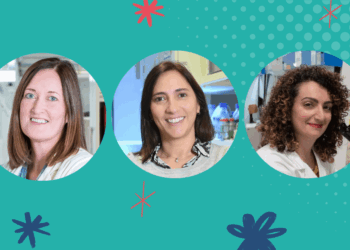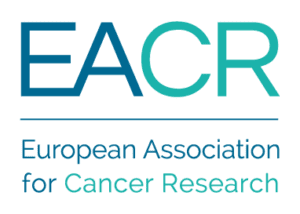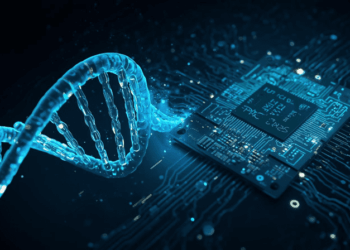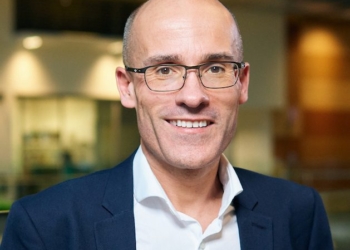In this episode of the Cancer Researcher Podcast we interview Matheus Diaz about his research in Rene Bernards’ lab on a ‘paradoxical’ approach to cancer treatment involving the activation of oncogenic signaling. The conversation explores how this method potentially kills cancer cells and addresses drug resistance, based on Diaz’s recent publication in Cancer Discovery.
This study, ‘Paradoxical Activation of Oncogenic Signaling as a Cancer Treatment Strategy’, was published in Cancer Discovery and was selected for the EACR’s Highlights in Cancer Research, showcasing its significance to the field.
Listen here, scroll down for the transcript and subscribe now via Spotify, Apple Podcasts, Amazon Music/Audible, Deezer or YouTube so you’ll never miss an episode. You can find all episodes and their transcripts here.
Our host is Alexandra Boitor, EACR Scientific Officer.
Episode transcript
Alexandra: Cancer initiation and progression revolves around activated oncogenic signaling and suppressed expression of tumour suppressor genes. Oncogenes who are activated in cancer are responsible for inducing and fostering tumour development. Hence, common approaches in the attempt to fight cancer focused on the inhibition of oncogenic signaling with various degrees of success, but a common culprit, cells eventually develop resistance to therapy.
More recent research brings strong evidence that cancer homeostasis relies on a balance between activated oncogenic and stress response pathways activated as a result of the inherent toxicity. Today, I have here with me Dr. Matheus Henrique Dias, Senior Scientist in the Laboratory of Rene Bernards at the Netherlands Cancer Institute, to elaborate on this and discuss a rather paradoxical proposal, as he calls it in his paper, to treat cancer by hyper activating oncogenic signaling.
Matheus, it is great having you as a guest on our podcast. Not least because this gives me the opportunity to meet Matheus the researcher, but also to meet Matheus the Chair of the EACR’s Early Career Researchers’ Council, and discuss your research for a change instead of brainstorming new ways of making the EACR community a supportive environment for early career researchers.
Matheus: Yeah, that’s actually true. It’s a completely different set-up!
Alexandra: I suspect it’s going to be a rather different conversation than the ones that we’ve had in the past, but I’m really looking forward to it.
Alexandra: Diving straight into today’s topic, the paper ‘Paradoxical Activation of Oncogenic Signaling as a Cancer Treatment Strategy’ you recently published in Cancer Discovery together with your supervisor, Rene Bernards, and your collaborators. May I first ask, what triggered your interest to explore hyperactivation of oncogenic signaling as a potential anti-cancer approach?
Matheus: That’s a good question and that question actually brings me back to the past. A few years before coming to the Netherlands, I was in the beginning of my postdoc, working in a lab that was not really dealing with cancer, but it was investigating the cell cycle and how cells actually move through the cell cycle. One of the tools that we were using back then to study the cell cycle was Fibroblast growth factor 2 (FGF2), which is a growth factor. So it was supposed to promote cell proliferation and promote progression through the cell cycle.
But it turned out that the lab was using for a very long time a KRAS driven cancer model. And in this KRAS driven cancer model, FGF2, instead of promoting proliferation, it was stopping the cells in the cell cycle. For a very long time, the lab tried to figure out what was going on, why FGF2 was doing exactly the opposite of what it was supposed to do. The prevailing notion back then was that it was probably not based on the same signaling pathways that fibroblast growth factor (FGF) normally activates. Because FGF was not supposed to do that, but because I didn’t have any background in cancer.
So for me, it could be just that FGF was doing exactly what it was supposed to do. But, because they were cancer cells, they were kind of on overdrive because of this activation. And that was exactly what I showed in this beginning of my previous postdoc. And that was what got me hooked on that idea that you could potentially over activate oncogenic signaling and with that, you would kind of overstress cancer cells and you could kill them based on those stresses.
Alexandra: Very interesting. This paradoxical approach, as you call it in your paper, is part of a new school of thought that started developing only in the past decade or so, am I right?
Matheus: Yes, it’s hard to know exactly when it started to develop. As I said, in my career, it was something like, 10-12 years ago, and I started to study that. But, multiple lines of evidence, popped up here and there. And if we really think straight, this notion should already be clear when we figured out that there was the very well known phenomenon of Oncogene induced senescence. Because it’s not very different. It’s just oncogenes or oncogenic signaling inducing a very strong stress response in cancer cells.
Alexandra: Throughout this study, you focused on inhibiting protein phosphatase 2A, by using its inhibitor LB-100. May I ask how or why did you decide to act on this phosphatase and not another?
Matheus: The reason to use this specific drug is that when I started here at the lab of René, I was really interested in developing and expanding and maturing this concept of the hyperactivation. So I wanted to find things or activators that, if we really understand how they work, and if we really can come up with interesting combinations, that we could test in patients.
And it turned out that there are a lot of different inhibitors of oncogenic signaling, but not a lot of activators. So I didn’t have many different options for that. And this drug, this LB-100, a PP2 inhibitor, was already considered pretty safe in a phase one clinical trial as a single drug. So I knew that if I find something interesting with this drug, I could potentially translate that into a clinical trial. And because PP2A is a phosphatase that inhibits many of those oncogenic signaling pathways that are normally deregulated in cancer cells, we figure that if we inhibit the inhibitor, we could get activation.
And because the drug was already through a phase one clinical trial, we could potentially use this, in patients if it works. So that was the only reason to choose exactly that specific drug.
Alexandra: So it was sort of a practical decision.
Matheus: Exactly.
Alexandra: So what effects have you noticed following PP2A inhibition in your experiments?
Matheus: Well, the first thing that we noticed was that indeed inhibiting PP2A was doing what we expected it to do, which was activating oncogenic signaling pathways in cancer cells, inducing a lot of stress responses, and suppressing the proliferation of these cells despite the activation. It’s not that they were cycling a little bit faster. It was exactly the opposite. They were getting stuck in the cell cycle, just like I observed very much in the past with the FGF2. They were really getting stuck in the cell cycle because of this overdrive of oncogenic signaling pathway. So we observed these effects and then we kept moving on and investigating what would be the best way to target these overstressed cells.
Alexandra: So, you decided to explore a dual approach, in a way. Hyperactivate oncogenic signaling and control the stress response. You design a custom stress focused drug library of compounds targeting stress response pathways associated with malignant phenotypes, including some senolytic drugs. Considering that senescence can be seen as a survival response of cells under stress. But your library, if I remember correctly, comprises about 164 selected compounds. So, how did you decide on targeting WEE1 in the end?
Matheus: Yeah, that’s a good question because, as I said, when we started treating the cells with LB-100, we noticed that a number of different stress response pathways were being engaged. So we didn’t know which would be the best stress response pathway to actually target in combination with the activation.
So that’s why we designed this library, because with this library, we could inhibit multiple different proteins in these different, stress response pathways that are normally associated with the malignant phenotype. And then we could just ask a very simple question, which of those drugs would be more toxic in the presence of this activation? And then from this stress focus screen, we identified some Checkpoint kinase 1 (CHK1) inhibitors and also WEE1 inhibitors. These inhibitors became more toxic in the presence of the activation. And because we had also a parallel CRISPR screen that, again identified the knockout of WEE1 as being synthetic lethal with the inhibition of PP2A.
We decided to focus on this combination of PP2A inhibition plus WEE1 inhibition. And also because the clinical development of the WEE1 inhibitors, by the time that we identify the combinations, were a bit further, compared to the development of the CHK1 inhibitors. So it was a pretty clinically relevant combination.
Alexandra: So now that I have a better understanding of the concept and drugs of choice, how does it all work? What are the effects that you’ve noticed on cancer cells?
Matheus: Yeah, the thing is, when we went to identify the mechanism, one thing that was the starting point was the mitosis, because in the end, PP2A itself has some effect on the mitosis, but also WEE1 is best known for being a gatekeeper kinase, controlling mitotic entry. So if cells have any problem during DNA replication or DNA damage or things like that, WEE1 tends to block the cell cycle and then to prevent these cells to enter mitosis.
So if you inhibit WEE1, they enter mitosis with DNA damage, which is definitely bad for cancer cells.
So, the first thing that we actually looked at was the mitosis and what we observed immediately was that the combination of the two drugs, each one had some effect on the mitosis, but the combination of the two drugs actually led to pretty much all the cells, when we were using this time lapse, microscopy. All the cells end up stuck in mitosis, in a very aberrant mitosis, up to 24 hours. And we also noticed that if you give them a little bit more time, they would start dying slowly in the presence of the combination while they would recover to their normal cell cycle after a few hours, if you just treat with the single drugs.
And then we even took a step back to figure out what was going on during the DNA replication. And what we noticed was that these cells in the presence of the combination, DNA replication was literally collapsing. So you had a collapse of the DNA replication and these cells were moving from the S phase straight to mitosis without even finishing DNA replication.
And that was obviously very toxic to the cells. So, that was, more or less, how we identified what was the phenotype, what was going on, why the cells were dying in the presence of this combination.
Alexandra: Another thing that I wanted to ask you is that both Adavosertib and LB-100 have been proposed as sensitisers for chemotherapy in the past. Adavosertib in preclinical studies and LB-100, I think it even reached clinical investigations. So, how does the combination of LB-100 and Adavosertib compare with each of these drugs in combination with chemotherapeutic agent?
Matheus: Yeah, that was in the end a very important question, because when we identified the combination, we also noticed that both drugs were being tried in the clinic in combination with chemotherapy. That was a very important and obvious experiment that we had to do, and we actually tested side by side the combination of Adavosertib and two different chemotherapy drugs and the combination of LB-100, plus two different chemotherapy drugs.
The combination of LB-100 plus Adavosertib was superior to all the other possible combinations. So it was pretty clear that you had much more synergy when you combine LB-100 and Adavosertib than when you combine each of the two drugs with the chemotherapy drugs.
Alexandra: Moving on a bit from how these drug combinations work, and getting back to the effects that they have on cancer progression, I’d like to touch a bit on the subject of resistance to therapy. Most, if not all, anti-cancer therapies proposed have over time determined tumours to develop mechanisms to resist or escape therapy.
From your paper, I understand that the approach you are proposing is no exception. However, you observed a very interesting and, I’d dare to say not at all detrimental, effect of therapy resistance in this case. Would you like to tell me a bit more about how you studied the acquired resistance to the combination of LB-100 and Adavosertib and its tumour suppressive effects that you observed?
Matheus: Definitely, because that’s also very interesting because in this manuscript, we decided to really go from hypothesis, to identify the combinations, to mechanism and to the tests in vivo, but also it will be very important to address resistance because in the end, it is the major challenge for cancer therapy.
But if I may, it’s important to make a small and even logical inference. We are very familiar with the scenario that we have for resistance to either chemotherapy or even targeted therapies. Because in the end, you inhibit the cell proliferation or the signaling pathways, and then you have some effect.
And then after this effect, the cancer cells manage to rewire the signaling pathways. And when they do that, they tend to become even more malignant than they were before. And even more difficult to treat with the next drug. But that happens when you are inhibiting oncogenic signaling. So we envision that because our treatment was actually over activating oncogenic signaling, it would be just logical to expect the opposite because to really survive this kind of treatment, cancer cells would have to either turn down some of their oncogenic signaling pathways or reactivate some tumour suppressor genes.
So that was more or less what we were expecting. And we were quite fortunate because from the very beginning of this investigation, even in CRISPR screens, we were already observing that if you knock out some oncogenes, the cells would become less sensitive to this overactivation. By the same token, if you overexpress some oncogenes, the cells will become more sensitive to this overactivation.
But the real proof was that we decided to select cells in vitro that were resistant to this overactivation of oncogenic signaling, to this combination that we are proposing. And observed a number of different, interesting things just to mention two of them. That these cells were actually now suppressing oncogenic signaling, even in the presence of the drug, which was exactly what we were expecting.
But we even noticed some more dramatic changes because, one of these models that we tested was highly unemployed. It had something like an average chromosome number of 70 or so. And then, after becoming resistant to the combination, they have on average, a nearly diploid karyotype.
So they become much less unemployed than they were before. But the real proof was to inject these cells now in mice. And when we did this, we noticed that these cells that became resistant to the combination, they were now either failing to grow tumours in mice or they were growing much smaller tumours, indicating that after becoming resistant to this approach, they became less malignant. What we called, tumour suppressive acquired resistance.
So it was really interesting to notice that the prediction that the resistance should go on the opposite direction actually materialised on the experiments.
Alexandra: That sounds great! So basically either the treatment works and kills the cancer cells. Or the cancer cells become resistant but lose their tumourigenic potential.
Matheus: That’s the idea. Let’s hope it also works like that in patients, right?
Alexandra: Sounds like a win-win to me. How about the toxicity of the proposed treatment approach? Did you notice and/or can you foresee any side effects?
Matheus: Yeah, that’s a good question. A very difficult one to answer because obviously during the manuscript we perform tests in non transformed cells in vitro. And we also observed body weight in the mice and even analysed a few vital tissues on these mice that were treated by the combination.
But this is all experimental work. The real proof that the combination is not toxic, we can only see, actually, when we have clinical trials, because in the end, we are very familiar with the situation that a number of drugs or drug combinations work very well in animal models, but they don’t work at all, or they are highly toxic for patients.
So, in this particular case, we are very aware that the clinical trials should be performed very carefully. Because we really need to be aware of potential toxicities arising for these combinations, especially because we didn’t see much context dependence in terms of what are the cancer cells that actually respond.
Because most of the cells that we tested on the manuscript actually responded. So we really need to be careful when testing this in the clinical setting
Alexandra: So what I noticed in your paper is that your experiments extended over the period of one month. I would expect that in clinical practice that probably wouldn’t be enough. So do you have any plans for additional long term in vivo experiments before you move into clinical trials?
Matheus: Yes, we are actually conducting a few long term experiments right now. I’m not entirely sure if they help very much to predict what’s going to happen in patients, because, as I said, we are now all too familiar with the situation that things work perfectly in animal models, but don’t work at all in patients. So I think it’s an important control, but the real deal is actually to test in patients, being very careful with the doses and with the monitoring of these patients.
Alexandra: So you show in your paper, as I think you’ve already mentioned, that this drug combination hyperactivates multiple oncogenic signaling pathways and simultaneously engages several stress response pathways. Is there a risk that this approach could induce tumorigenesis in normal or precancerous cells?
Matheus: Well, that’s the question that you get in all presentations, right? When you finish presenting, the first hand to ask the question, that’s exactly the question that comes.
Alexandra: At least it wasn’t my first question, but it’s still on the list though.
Matheus: No, definitely, this is an important question. There are a number of different tides to approach that question. I tend to prefer to approach first from the more conceptual perspective. Because, if there is one thing that we know about cancer cells, is that they have increased oncogenic signaling, defect feedback to control that signaling and tonic stresses.
So, because of these intrinsic characteristics of cancer cells, we should expect that they are much more sensitive to this approach compared to normal cells. So there should be a therapeutic window, particularly because normal cells, by definition, they must have some intact feedbacks to control oncogenic signaling because if they didn’t have this feedback, they would be cancer cells and not normal cells in the first place.
So they should have those feedback to control oncogenic signaling. But there’s also a more pragmatic approach because we have, for instance, not LB-100 per se, but we have the dual lithium chloride that has been used in clinical practice for bipolar disorder for many, many decades. And despite the fact that the lithium chloride is a GSK3 beta inhibitor, and therefore, activates the Wnt pathway, which is a major driver for colorectal cancer.
When they looked at these patients that were treated with lithium chloride, they could not observe any increase in cancer incidence. If anything, there was a slight decrease in the incidence of gastric cancers in these patients that were treated for decades with an activator of oncogenic signaling pathway.
So it looks like that pre malignant cells, or even cancer cells, they are not waiting for more signaling to grow. They’re actually waiting for something else, maybe for ageing or for inflammation, but not necessarily more signaling. More signaling seems to be harmful even for pre malignant cells.
Alexandra: It really seems like a great approach at least on paper from preclinical studies So my last question would have been what are the next steps for this study? But you’ve already mentioned you plan on taking it into clinical trials. So I’ll rephrase my question and ask you if you have any sort of timeline in mind for the beginning of the clinical trials, and if you’re planning on further investigating the molecular mechanism into more detail in parallel to that.
Matheus: Yeah, these are very important questions. I used to give a timeline for the clinical trials to say, “Oh, are you expecting to have the clinical trial in the next coming month?”. But I’ve been doing this for quite some months already. And I realised that the amount of bureaucracy that is involved in those clinical trials, it is really immense.
And there are a number of unforeseen events that you cannot really control, and that are totally outside of the lab. They’re legal aspects of clinical trials. So the real answer is that I really don’t know when the clinical trial is going to start. We have the protocol written, we have agreements with companies and with the hospital, with our phase one unity, but it really depends on a number of bureaucratic details that are completely outside of my scope.
And for the further investigation, it’s important to mention that this combination is only one combination. The approach, the idea that you can essentially over activate oncogenic signaling in cancer cells, and combine that with stress targeted drugs. It’s a concept that is much broader than this simple combination.
So, what we are doing right now is try to identify other combinations based on the same concept and try to understand for each of those different activators, or different drug combinations, understand exactly what is going on and how we can make it better and how we can develop new activators, given that we, as I said, we have a number of different inhibitors, but not a lot of activators.
So the idea is to exploit this concept now in a much broader way for different cancer types, different drugs. So this is really a completely new and very much untapped field of research, which is much bigger than the combination that we actually proposed right now.
Alexandra: Well, everything we discussed today points towards a very promising approach on the horizon for the treatment of cancer. The data presented in your paper and discussed today shows considerable context independence of the synthetic lethality between the two drugs used, namely LB-100 and Adavosertib. As you used models from diverse genetic backgrounds you tested seven different colorectal cancer cell lines with various driver mutations and different tissues, between the in vitro and in vivo experiments.
I think you’ve looked at colon cancer, pancreatic cancer, and bowel duct cancer. So, thank you very much for having this conversation with us and presenting your research on The Cancer Researcher Podcast. Thank you for allowing us a glimpse into your research by accepting our invitation.
Matheus: Thank you very much. It was really a pleasure to have that conversation with you.
Enjoyed it? Stay curious with The Cancer Researcher Podcast. Subscribe now via Spotify, Apple Podcasts, Amazon Music/Audible, Deezer or YouTube so you’ll never miss an episode. You can find all episodes and their transcripts here.
Suggest a topic for a future episode: What would you love to learn more about? Click here to give us your topic suggestions in a short online form. We warmly welcome your ideas and input!









